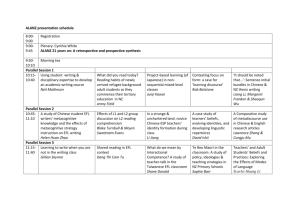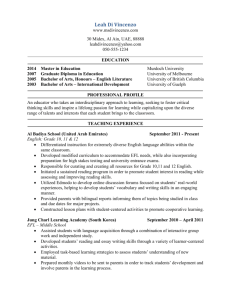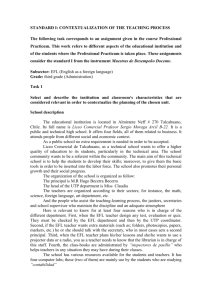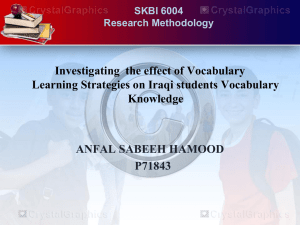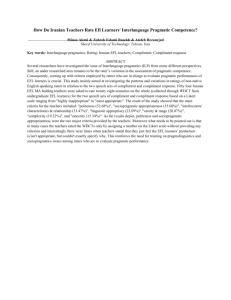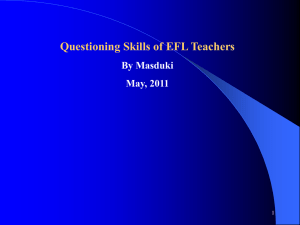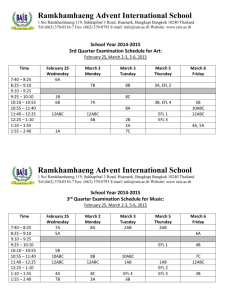SWOT Analysis on Chinese ESL Teaching & Learning
advertisement
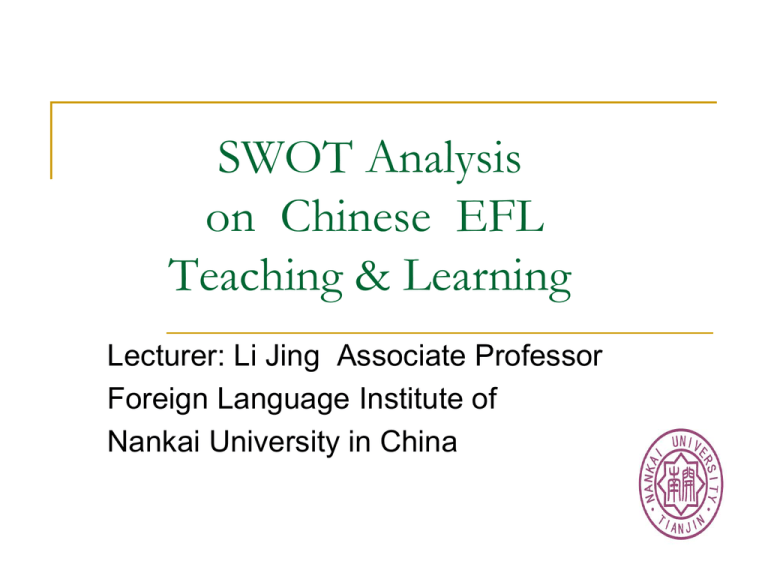
SWOT Analysis on Chinese EFL Teaching & Learning Lecturer: Li Jing Associate Professor Foreign Language Institute of Nankai University in China SWOT: (TOWS Analysis or Matrix) which is widely used in Business Administration S = strength, competence W= weakness, inefficiency O = opportunity, challenge T = threats, plight Weihrich SWOT Matrix Strengths: Weakness: 1.Policy-makers 2.Teachers 3.Students 1.Teaching resources 2.Teaching methods Opportunities: Threats: 1.Teacher 2.Student 1.Cultural perspective 2.Chinese ESL ways 3.Identity of the students General Look on EFL in China 300 million English Learners Dewey Change puts a definite responsibility upon the schools to sustain our true national democratic spirit. The virtues of mutual esteem, human forbearance and well-wishing, which in our earlier days were unconscious root of an education which forms the deepest springs of character. Strengths 1.Government launched lots of policies to sponsor the educational reform and projects in EFL. Strengths 2. More and more teachers are aware of the emergency of educational reform, so they brought some new concepts into classroom practice. (project-based learning, website resources sharing, multimedia teaching,entrepreneur encouraging, etc.) Strengths 3. Students are more competent and active in the presentation of intellectual English potentilities. Weakness 1. Teaching resources 1)Teaching resources are short. Technology is not made full play in EFL teaching and learning. 2) Majority of EFL teachers are lack of training. Weakness 2.Teaching Method 1)Test-oriented approach is outstanding. 2)Unable to integrate language and content in language classroom 3)Inability in producing integrative students who are professionally competent 4) Assessment approach is still single. Opportunity 1. China is in the transitional period, not only on economy, but on education. a)From nationalism to internationalism b) From foreign language education to eduaction for intercultural citizenship c) From centered to decentered Opportunities 2. Students have more creativity and insight in doing things. a)From linguistic competence to intercultural competence b)From closed-minded to open-minded c)From instrumental to integrative Threat 1. Cultural awareness in the modern world is still the weakness of EFL teaching and learning in China. 2. China hasn’t got its own systematic theories in EFL teaching and learning. 3. Misposition of identity is the potential danger for Chinese students. The Transforming Role of Teacher at Transitional Period One of the policy-maker practioner witness Source: edited by the speaker Schools can be a vehicle for social change, but let us not overestimate the strength, actual or potential, of that impact. Far more powerful is the impact of society on schools, an impact that in recent decades has been as fruitless as it has been powerful. (Seymour B.Sarason 1990) The Socialization Process identification reorientation changing one’s citizenship changing direction of one’s life Re-evaluation giving up of certain values for new ones appreciation perception process of changing one’s values Coming to know and to like Source:edited by the speaker from Paulston, 1992:124 There is a joke: It is about a man who in the dead of winter was ill and went to his physician. After a through examination he was told to go home, take off all his clothes, open all the windows, stand in front of them, and breathe deeply and long. To which the man responded in amazement: “But, doctor, if I do that I will get pneumonia!” And the doctor replied: “That is something I know how to deal with.” Educational reformers take note. Strategies on EFL Teaching and Learning Cultural awareness should be the first lesson to learn. Integrate our Chinese culture into the EFL teaching and learning. Such as Buddhism,Taosim,etc. The tertiary position: not replace national identity with an international identity. EFL reform is at the transitional period Teaching Form teacher-centered student-centered Classroom environment passive active Language Content grammar-oriented content-oriented Learners’ motivation instrumental integrative Psychological factor externalized internalized Course design text-based Content based /project-based Source: compiled by the speaker Tactics on EFL Teaching and Learning (refer to some of the paras. of Stephen B. & Betty Leaver, 1997) Learning by doing should be the main theme of the classroom tactic. Total integration of language and content learning. From top-down to buttom-up in organization of classroom activities. Affective factors(students’feeling and emotional reactions) should play more important role in students’ motivation. Classroom goals are focused on all of the components of communicative competence and not restricted to grammatical or linguistic competence. Language techniques are designed to engage learners in the pragmatic, authentic, functional use of language for meaningful purposes. Fluency and accuracy are seen as complementary principles underlying communicative techniques. In the communicative classroom, students ultimately have to use the language, productively and receptively, in unrehearsed contexts. Varify the check for students’ performance Link to some websites: such as Computer Chronicles Newswire; TED Conclusion My understanding on “teach” effective tolerant academic human cooperative All Roads Lead to Rome Dewey Democracy and Education Human & Nature Should Coexist Maslow Confucius Humanism Source:edited by the speaker the Analects of Confucius As a Chinese minister said: For English language teaching in China, we need a method that is Chinese. Acknowledgement Raymond: CRLC Organizer Carol Fraser: My wise mentor and true friend during my Glendon trip Brain Morgan: My enlightner on research road Ian Martin: My model to be a qualified teacher Linda Steinman: My respected professor Ron Sheese: My leader to Dewey Sunny: My workmate Lanxia Zhang: My workmate xbz91@yahoo.com.cn jianadalijing@gmail.com

